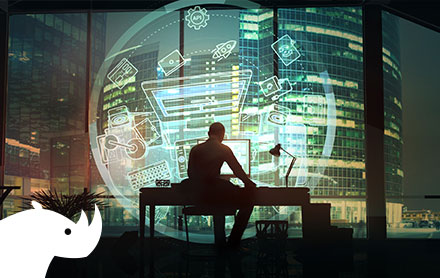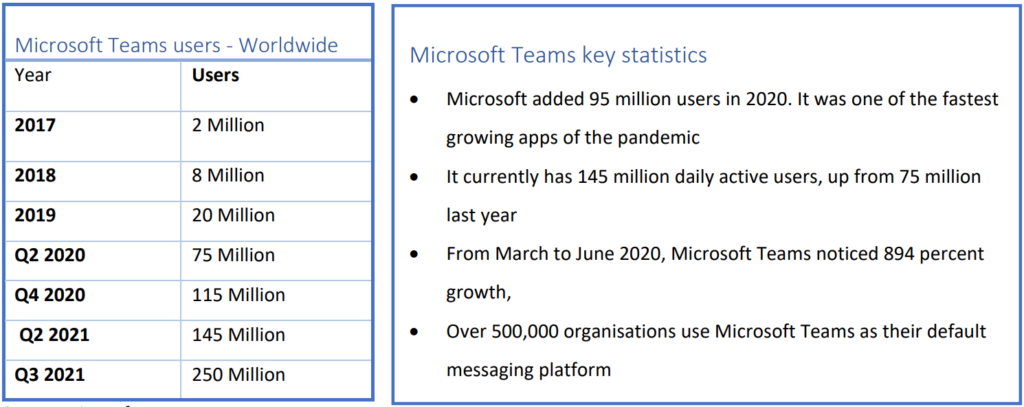The Challenges of Hybridization in the Modern Workplace: Perspectives and Strategies
The Emergence of Hybridization Hybridization of IT infrastructures is a major challenge for businesses, whether they are small or large....

In recent years, our work environments have changed dramatically. The Covid-19 pandemic has completely revolutionized workplace standards.
Generally, changes in a company are well thought out and anticipated. They occur over time, but never or rarely suddenly. The health crisis is one of those exceptions that could not have been anticipated and which has radically changed the way we work.
Of course, teleworking, video conferencing solutions, the cloud, remote access, etc. Widespread remote working has accelerated changes and adoptions of technology. The most obvious example is the case of Teams: a 12x growth in the number of Teams users since 2019, an exponential growth as shown in the elements below:

The following axes are not purely technological axes but rather trends and reflections related to the evolution of the workplace. For each axis, we will inevitably find its share of technologies and technical solutions that will naturally be added to it. These areas are as follows:
Intranets are back 😊, but not the intranets we’ve all known that bring together sets of links, which are cumbersome to maintain, often remain static.
VIVA’s integrations in Teams make it possible to quickly deliver content in Teams in a centralized manner, making it a more relevant intranet than ever. In addition, as Teams has become one of the most used tools by the company’s employees, the lists of intranet links will give way to a personalized and reliable cloud-based two-way communication channel within Teams.
The new features announced by Microsoft during the last Ignite suggest that Teams and related products will take centre stage again this year by improving communication and exchange experiences, particularly with the recent Microsoft-style Mesh and Metaverse experiments. So for 2022, inevitably, there will be topics around Teams. By the way, Microsoft has just created and launched a new YouTube channel dedicated to Teams: Microsoft Teams – YouTube
Employees want to log in in one place to access all their productivity tools. The digital workspaces of 2022 will include proprietary applications as well as third-party tools such as ServiceNow and many others, all within Microsoft Teams.
It is therefore a safe bet that the modern Workplace and collaborative tools will be in the spotlight this year, with a large part of the activities on extending the scope of Teams by integrating existing or future complementary functions.
Hybrid work is a term that has recently emerged that marks the mix of one-off telecommuting, on-site work, moving to the office, and full-time telecommuting. Nothing to do with the cloud hybridizations we use to connect onPrem and cloud environments.
These are the new ways of working that have emerged after the lockdown and widespread teleworking. This hybrid way of working represents the fact that an employee’s workplace is no longer just the office or the location they use, but includes their home, company premises or a temporary place (travel, hotel, internet café).
Microsoft CEO Satya Nadella coined the term “hybrid paradox” due to the apparent disconnect between employees wanting flexible work options to continue (70%) but also expressing a desire for more in-person contact with their teams (65%).
Clearly, there is no one-size-fits-all solution for successful hybrid work. This is clear from Microsoft’s findings where employees cited the same reasons for wanting to work in different ways, for example 58% of employees who plan to spend the most and least time in the office plan to do so for the same reason: more focused work.
The key to success, according to Microsoft, is therefore to create a culture of trust and flexibility and to rely on technical solutions that are just as flexible and meet user expectations.
The term Hybrid work is also a “marketing” element introduced with the arrival of Windows 11, since this OS in its new version has been designed for hybrid work that reduces the difference between professional and private use of the same device.
If it is still too early to talk about the generalization of Windows 11 in the enterprise, this step will be inevitable after some time and it will also be necessary to adapt the deployment processes of Windows 11 workstations and of course here Autopilot and Microsoft Endpoint Manager are the most appropriate tools and simplify the provision of workstations to users, whether they are on-site or off-site.
The need to work remotely has led Microsoft to focus on creating more inclusive hybrid meetings in 2021.
“Inclusion is defined by the ability to feel comfortable contributing ideas and perspectives,” says Sara Bush, senior program manager on Microsoft Digital’s Seamless Teamwork team. “In an inclusive and effective meeting, I can participate fully because I have access to all relevant documents, content, and people before, during, and after. It allows me to get involved and contribute from anywhere. »
All these elements have contributed to the evolution of Teams with the together mode, but above all Teams is a very good tool for virtual meeting management “everyone in their own corner”, it turned out that hybrid meeting management was more complex between individual participants and participants gathered in a room, here again, we find the beginnings of the future of Team and the Metaverse.
Of course, all of this requires the implementation of increasingly stringent security policies. While security aspects are already being addressed within companies of all sizes, security is also on the rise at the beginning of the year and 2022 is bound to be a year that will see the increase in the adoption and evolution of zero trust policies.
This is not necessarily a technological point but rather a trend. For more and more companies since the beginning of the health crisis, coworking spaces are booming. This office model has been democratized for a few years now, but the phenomenon is increasing. Many small structures no longer have an interest in having permanently dedicated premises and potentially only need premises occasionally or for short periods of time. During the health crisis, these coworking spaces are also a way for self-employed workers to have an ‘individualized’ office in a coworking space to avoid working from home. We can therefore imagine more and more the packaged needs that these coworking spaces could make available, in particular to offer offices with videoconferencing solution “room systems” on demand with the expected levels of services including hardware reset and other operations between the different occupants. More and more coworking spaces are also offering IT and technical support.
The very idea of coworking is flexibility, hybrid work is also based on flexibility, so it becomes concretely possible to spend one or more days in a coworking space, telecommuting or on the company’s premises depending on travel.
All major cities now have co-working spaces, what could be simpler than taking a train to go to work for a day or two in a small team in a city where there is a client or one or more people with whom it is required to interact in person.
Technologies such as artificial intelligence (AI) and machine learning (ML) have become prominent trends in the workplace. These technologies make it easier for recruiters to optimize the hiring process, including screening and adaptation. Additionally, when evaluating candidates, AI and ML can help employers address various common recruitment gaps, such as subconscious bias among recruiters.
These technologies can also be used to increase employee productivity by automating repetitive tasks, allowing workers to focus on more creative and valuable work. It also gives employees more opportunities to improve their skills. In a recent survey, 72% of business leaders said AI could allow employees to focus on meaningful work, while 34% said AI could help free up time for more meaningful and valuable work.
Beyond this observation around the significant emergence of AI in companies, we can wonder what field of application AI could impact in the modern workplace. It is important to keep in mind that AI is a way to process large volumes of data automatically and intelligently after a learning phase. It could also be an answer for research and consolidation, through the different sources of data available in companies (directories, asset management, databases), of the various information of the users of their equipment and the tools they use to quickly obtain reliable information on the resources made available. This is an element that is becoming more and more important, especially in a hybrid work context where it becomes essential to have this information in order to reliably manage data and provide the required levels of security for any user, wherever they are.
As far as the workplace is concerned, an important application of AI is coming of age. It is the understanding of the functioning of the workstation through the collection of all its logs, by making them available in a datalake to analyze the strong and weak signals. Thus, in anticipation, it is possible to predict a future incident against a set of users by correlating all these elements. Here, too, there is still work to be done and expanded.
Articles Similaires
The Emergence of Hybridization Hybridization of IT infrastructures is a major challenge for businesses, whether they are small or large....
The definition of roles and scopes in IT tools is a central issue in a modern workplace project. Due to...
Personal devices in the workplace are common, with many employees, both internal and external, preferring to use their own devices...